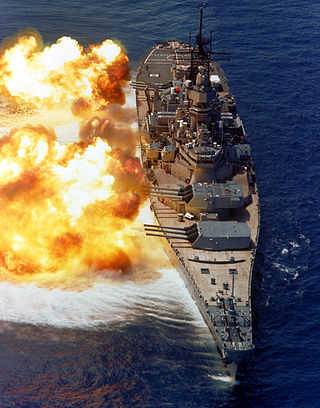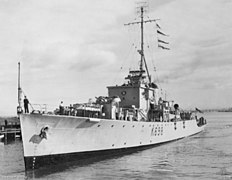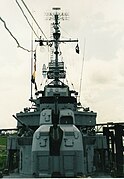The United States Navy, United States Coast Guard, and United States National Oceanic and Atmospheric Administration (NOAA) use a hull classification symbol to identify their ships by type and by individual ship within a type. The system is analogous to the pennant number system that the Royal Navy and other European and Commonwealth navies use.

USS Alabama (BB-60) is a retired battleship. She was the fourth and final member of the South Dakota class of fast battleships built for the United States Navy in the 1940s. The first American battleships designed after the Washington treaty system began to break down in the mid-1930s, they took advantage of an escalator clause that allowed increasing the main battery to 16-inch (406 mm) guns, but Congressional refusal to authorize larger battleships kept their displacement close to the Washington limit of 35,000 long tons (36,000 t). A requirement to be armored against the same caliber of guns as they carried, combined with the displacement restriction, resulted in cramped ships. Overcrowding was exacerbated by wartime modifications that considerably strengthened their anti-aircraft batteries and significantly increased their crews.

USS Indiana (BB-58) was the second of four South Dakota-class fast battleships built for the United States Navy in the 1930s. The first American battleships designed after the Washington treaty system began to break down in the mid-1930s, they took advantage of an escalator clause that allowed increasing the main battery to 16-inch (406 mm) guns, but refusal to authorize larger battleships kept their displacement close to the Washington limit of 35,000 long tons (35,562 t). A requirement to be armored against the same caliber of guns as they carried, combined with the displacement restriction, resulted in cramped ships, a problem that was exacerbated as wartime modifications that considerably strengthened their anti-aircraft batteries significantly increased their crews.

USS South Dakota (BB-57) was the lead vessel of the four South Dakota-class fast battleships built for the United States Navy in the 1930s. The first American battleships designed after the Washington treaty system began to break down in the mid-1930s, the South Dakotas were able to take advantage of a treaty clause that allowed them to increase the main battery to 16-inch (406 mm) guns. However, congressional refusal to authorize larger battleships kept their displacement close to the Washington limit of 35,000 long tons (35,562 t). A requirement to be armored against the same caliber of guns as they carried, combined with the displacement restriction, resulted in cramped ships. Overcrowding was exacerbated by wartime modifications that considerably strengthened their anti-aircraft batteries and significantly increased their crews.

The Iowa class was a class of six fast battleships ordered by the United States Navy in 1939 and 1940. They were initially intended to intercept fast capital ships such as the Japanese Kongō class and serve as the "fast wing" of the U.S. battle line. The Iowa class was designed to meet the Second London Naval Treaty's "escalator clause" limit of 45,000-long-ton (45,700 t) standard displacement. Beginning in August 1942, four vessels, Iowa, New Jersey, Missouri, and Wisconsin, were completed; two more, Illinois and Kentucky, were laid down but canceled in 1945 and 1958, respectively, before completion, and both hulls were scrapped in 1958–1959.

USS Liscome Bay (ACV/CVE-56) was the second of fifty Casablanca-class escort carriers built to serve the United States Navy during World War II. Launched in April 1943 and commissioned the following August, she was named for Liscome Bay in Dall Island in the Alexander Archipelago of Alaska. On 24 November 1943, her munitions were catastrophically detonated by a torpedo attack by the Japanese submarine I-175 while she was acting as the flagship of Carrier Division 24, which was supporting operations on Makin. She quickly sank with the loss of 702 officers and sailors. Her loss is the deadliest sinking of a carrier in the history of the United States Navy.

The Battle off Samar was the centermost action of the Battle of Leyte Gulf, one of the largest naval battles in history, which took place in the Philippine Sea off Samar Island, in the Philippines on October 25, 1944. It was the only major action in the larger battle in which the Americans were largely unprepared. After the previous day's fighting, the Imperial Japanese Navy's First Mobile Striking Force, under the command of Takeo Kurita, had suffered significant damage and appeared to be retreating westward. However, by the next morning, the Japanese force had turned around and resumed its advance toward Leyte Gulf. With Admiral William Halsey Jr. lured into taking his powerful Third Fleet north after a decoy fleet and the Seventh Fleet engaged to the south, the recently-landed 130,000 men of the Sixth Army were left vulnerable to Japanese attack on Leyte.

USS Johnston (DD-557) was a Fletcher-class destroyer built for the United States Navy during World War II. She was named after Lieutenant John V. Johnston, an officer of the US Navy during the American Civil War. Johnston was laid down in May 1942 and was launched on 25 March 1943. She entered active duty on 27 October 1943 under the command of Lieutenant Commander Ernest E. Evans and was assigned to the US Pacific Fleet. Johnston provided naval gunfire support for American ground forces during the Gilbert and Marshall Islands campaign in January and February 1944 and again, after three months of patrol and escort duty in the Solomon Islands, during the recapture of Guam in July. Thereafter, Johnston was tasked with escorting escort carriers during the Mariana and Palau Islands campaign and the liberation of the Philippines.
The names of commissioned ships of the United States Navy all start with USS, for United States Ship. Non-commissioned, primarily civilian-crewed vessels of the U.S. Navy under the Military Sealift Command have names that begin with USNS, standing for United States Naval Ship. A letter-based hull classification symbol is used to designate a vessel's type. The names of ships are selected by the Secretary of the Navy. The names are those of states, cities, towns, important persons, important locations, famous battles, fish, and ideals. Usually, different types of ships have names originated from different types of sources.

The CXAM radar system was the first production radar system deployed on United States Navy ships, operating in the mid-high VHF frequency band of 200 MHz. It followed several earlier prototype systems, such as the NRL radar installed in April 1937 on the destroyer Leary; its successor, the XAF, installed in December 1938 on the battleship New York; and the first RCA-designed system, the CXZ, installed in December 1938 or January 1939 on the battleship Texas. Based on testing in January 1939, where the XAF was more reliable, the US Navy ordered RCA to build six XAF-based units for deployment and then shortly thereafter ordered 14 more.

The 3"/50-caliber gun in United States naval gun terminology indicates the gun fired a projectile 3 inches (76 mm) in diameter, and the barrel was 50 calibers long. Different guns of this caliber were used by the U.S. Navy and U.S. Coast Guard from 1900 through to 1990 on a variety of combatant and transport ship classes.

The AN/SPS-49 is a United States Navy two-dimensional, long range air search radar built by Raytheon that can provide contact bearing and range. It is a primary air-search radar for numerous ships in the U.S. fleet and in Spain, Poland, Taiwan aboard Oliver Hazard Perry-class frigates, Canada on its Halifax-class frigate and New Zealand on its Anzac-class frigates. It formerly served in a complementary role aboard Aegis cruisers with the AN/SPY-1 but the systems are currently being removed during routine upgrade with no replacement.

Ship gun fire-control systems (GFCS) are analogue fire-control systems that were used aboard naval warships prior to modern electronic computerized systems, to control targeting of guns against surface ships, aircraft, and shore targets, with either optical or radar sighting. Most US ships that are destroyers or larger employed gun fire-control systems for 5-inch (127 mm) and larger guns, up to battleships, such as Iowa class.

AN/SPS-6 is a two-dimensional radar manufactured by Bendix and Westinghouse Electric. It was used by the US Navy as a first-generation air-search radar after World War II, and was widely exported to allies. In addition, the improved AN/SPS-12 is the derivative types developed in other countries.

AN/SPS-10 is a two-dimensional radar manufactured by Raytheon Technologies. It was used by the US Navy as a surface-search radar after World War II and was equipped aboard naval ships during the Cold War. Variants include AN/SPS-10B, AN-SPS/10E, and AN/SPS-10F.

AN/SPS-8 is a two-dimensional radar manufactured by General Electric. It was used by the US Navy as a height finding radar after World War II, and was equipped aboard naval ships during the Cold War. Variants include AN/SPS-8A, AN-SPS/8B, AN/SPS-8C and AN/SPS-8D After modernization, it was redesignated as AN/SPS-30.

AN/SPS-29 is a two-dimensional radar that was manufactured by General Electric. It was used by the US Navy as an early warning radar after World War II, and was equipped aboard naval ships during the Cold War. Variants include AN/SPS-29A, AN/SPS-29B, AN/SPS-29C, AN/SPS-29D and AN/SPS-29E. After modernization, it was redesignated as AN/SPS-37.

SK was an American-made air-search radar used during World War II by the United States Navy. Models included SK-1, SK-2 and SK-3.

SM was an American made fighter-direction radar used for the ship ground-controlled interception (GCI) during World War II by the United States Navy. Variation included the SM-1.
























